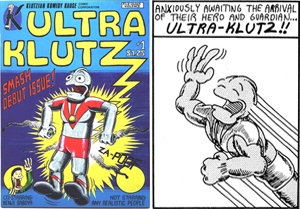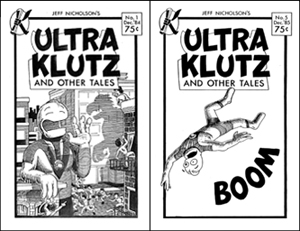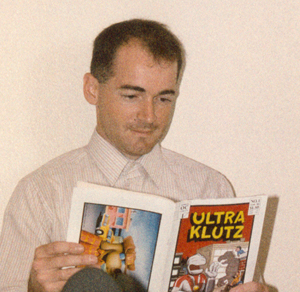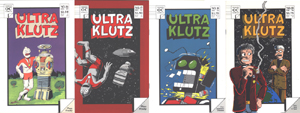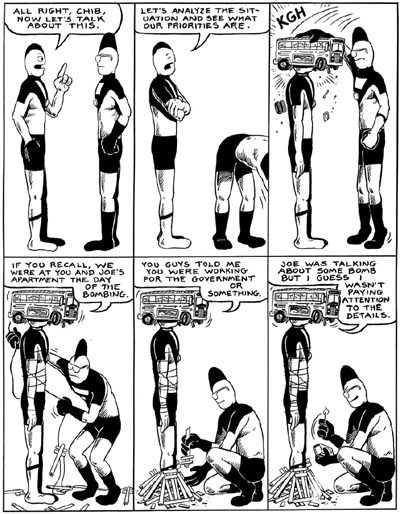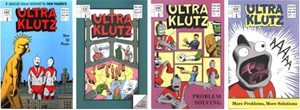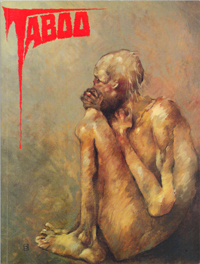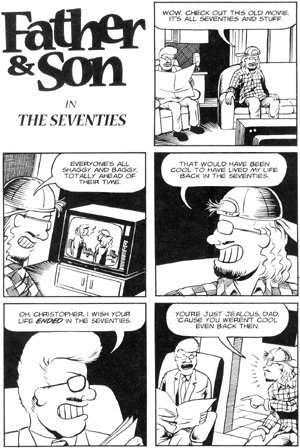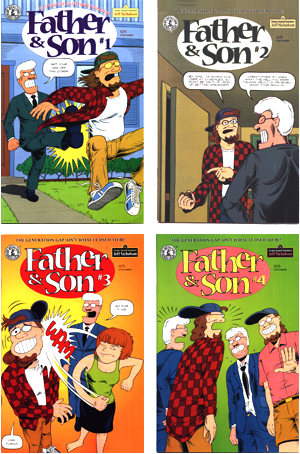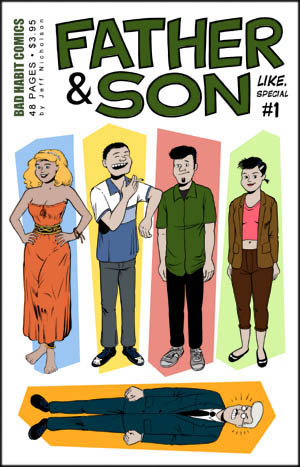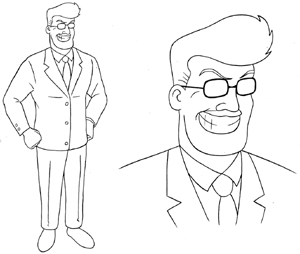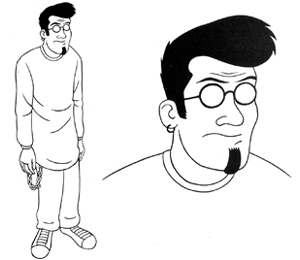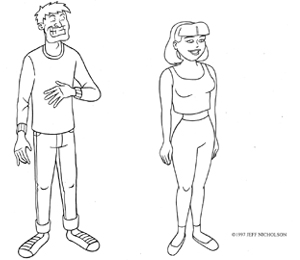LEAVING COMICS (NICHOLSON'S LAST SMALL PRESS TIRADE): 2005
In 2005 I stopped obsessively pushing myself down the vanishing highway of the American printed comic book market. Even though they bloomed and have been legitimized as an art form, comic books are no longer a mass medium, no longer a way to make an even meager living. My goals have not just been artistic, but to sell a lot of copies, just like the role models I emulated in the 70s, 80s and even the 90s. This pursuit was like climbing a peak on a sinking island. When I got to the top I was back at sea level. A stable, year after year circulation of even 2,000 copies on a creator owned comic book series has been proven impossible. *sigh*, life goes on.
I've had some real highs to be sure. Six Eisner Award nominations, fantastic fan mail, and some great reviews that fill my scrapbooks. My first three series started off strong, with sales around 18,000 (Ultra Klutz), 10,000 (Habitrails, via Taboo), and 3,800 (Father & Son), but comics generally have diminishing returns after making a splash. Less sales, less reviews, less mail. I don't take it personally. In a shrinking medium, retailers and distributors struggle to make room for something new to break the shrinking cycle, but are forced to cut everything else 5-10% per issue to do so, even if they believe in those titles 100%. Each of those series eventually dropped below the 1,200 copy mark (the financial break even), even though I was improving as an artist and promoting more aggressively. I dutifully completed those stories, sort of riding on the fumes of my old passions, with blinders on to the fact that the potential I grew up with was not really there any more.
In 1997 I "quit comics forever" for about six months or so. Then I started Colonia. I decided I hadn't given it my personal best yet. My more recent work had been getting polluted by obsessing over sales, so I focused totally on the art and the back story research. I was rewarded with a new lease on life. The first issue sold 3,000 copies. Including the second printing and trade paperback collection, that first story now has cumulative sales of over 5,000. Wow! That kicks ass.
But the old patterns returned. By 2004, after busting my ass with a bi-monthly schedule on the 9th, 10th and 11th issues, and spending $3000 in advertising, the sales slid down below the 1,200 copy break-even. I held out hope that readers were not buying the single issues in anticipation of trade paperback reprints, but the second of those (collecting issue 6-11) came out the following year and only sold 300 copies. That was the final blow. I could not dust myself off and dutifully complete Colonia when it was spiraling into obscurity, as I had on other series in the past.
GHOST TOWN AND DESERT TREK PHOTO ESSAYS: 2010-Present
In the year 2000 I enbarked on a four day 1600 mile tour of California and Nevada deserts. This led to nearly all my vacationing being done in remote corners of desert parks and BLM lands.
In 2010 I decided to start photo journaling all of these adventures via Flickr.
They will bore you to tears if you aren't passionte about the majesty of the desert and the vanishing ghost towns,
but if you are, these 30 treks include over 3,000 photos, details of the routes and locations, and each photo is georeferenced and mapped.

GHOST TOWN / DESERT TREKS
|
ANIMATION: 1978
At age 15 I got a super-8 camera and made several animations and claymations, the most ambitious being the
seven minute full color Justice Chumps cartoon.

FATHER & SON (V1): 1982-1984
Long before the real Father & Son comic series by Kitchen Sink Press, the characters existed in the form of doodles, home made comics, and
even musically in some of the "cartoon bands" we used to record in our music projects. This was purely for private goofs and
I never had any intention of trying to do anything commercial with them until the 90's.
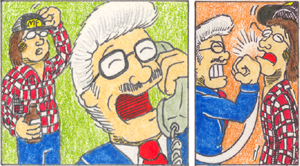
LIVE ACTION FILMS & VIDEOS: 1985
Because I was 22 years old and brimming with energy, I decided a quarterly zine and recording projects on top of college was
not enough, so I dusted off the old super-8 and made some Father & Son films. Then I realized a video camera was that much easier. Below are a few scenes.

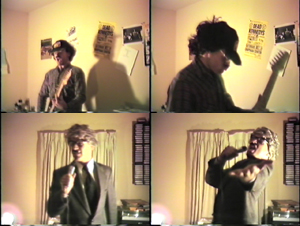 In addition to Father & Son I started using video for our cartoon bands like "Big Z and the Speed Freaks", performing Call of the Wired.
In addition to Father & Son I started using video for our cartoon bands like "Big Z and the Speed Freaks", performing Call of the Wired.

NICHOLSON'S SMALL PRESS TIRADE: 1989
When Ultra Klutz was on hiatus for a year I made a brief return to photocopy small press. In this self-examination of creativity and the search for audience, I openly criticized the faults and self-delusions of the small press community, which caused some heated controversy in its original release.
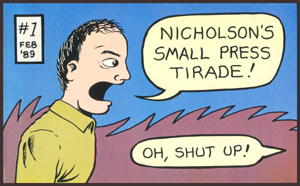
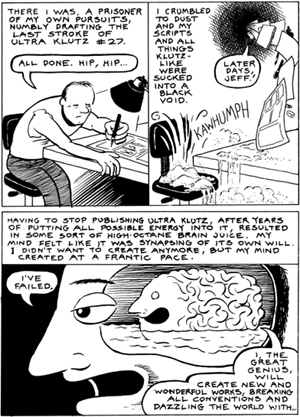
ULTRA KLUTZ: 1990-1991

Despite my growing success with Habitrails, my Ultra Klutz obsession was still very much alive and I released issues 28 to 31. Sales continued to drop and the series went on hold indefinitely. In a last ditch effort I created Ultra
Klutz Dreams, a series of stand-alone short stories that were created for an anthology
comic in 1991. They were more absurd and funny than the main series (which was getting more dramatic), with a clean
art style meant to be reminiscent of animated cartoons. The anthology folded faster than Ultra Klutz itself and I eventually issued the short stories in a stand alone comic in 1998.

LOST LAUGHTER: 1993-1994
In perhaps one of my worst career moves, I channeled my new found dark humored skills on Habitrails into my still active Ultra Klutz obsession, in the form of an Ultra Klutz sequel.
Lost Laughter was a subtle and
eccentric series that started with a basic premise: A
comic book universe that was once lighthearted and
whimsical is now "doom and gloom" (bleak revisionist history was a big trend in comics at this time). In my stab at it,
it is the Ultra Klutz characters and settings that
go Kafkaesque. The story is set in motion when some of
the characters begin regaining memory of the simpler
times, and stumble upon clues that explain just how this
transformation occurred. A race ensues to solve the
mystery and get the universe put back to right before it
decays into unmanageable chaos.
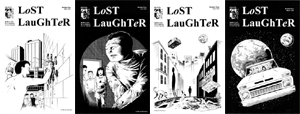
Lost Laughter was my biggest sales disaster. I released four issues and only survived
bankruptcy due to the fact that it was made possible by a grant from the
Xeric Foundation. I dutifully finished the series in three additional chapters in
the Caliber Press anthology Negative Burn. |
NO REGRETS / THE DREAMING: 1996
In late 1994 DC Comics' Vertigo imprint invited me to write some issues of The Dreaming, a spin off of the popular Sandman series, which was just in the planning stages. I worked on a proposal for a five issue story arc called No Regrets, but they decided it would be best if I start over with a single issue focusing on their Mervyn Pumpkinhead character, but that I would also draw it. Writing and drawing a single issue was actually more appealing than writing a multi-issue story arc. For reasons unknown or long forgotten, it took until January of 1996 to actually receive contracts and a green light from Vertigo so I could proceed. By then I had taken the No Regrets story and condensed it down and drew it myself. It was published in chapters in the Negative Burn anthology (#30-#36) by Caliber Press. This was never collected into a single book so I've posted an online version in my
Web Comics section.
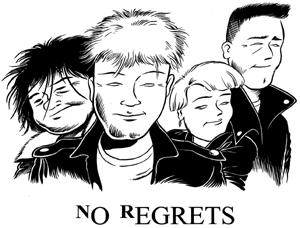 But getting back to The Dreaming, the money was great (over $300 a page for script, pencils and inks combined) and all delays aside I turned in some top notch work. It also has pro lettering by Todd Klein and excellent color by Danny Vozzo. It was later collected in the Vertigo trade paperback, Through the Gates of Horn and Ivory.
I believe all of the Vertigo trade paperbacks are available at amazon.com.
But getting back to The Dreaming, the money was great (over $300 a page for script, pencils and inks combined) and all delays aside I turned in some top notch work. It also has pro lettering by Todd Klein and excellent color by Danny Vozzo. It was later collected in the Vertigo trade paperback, Through the Gates of Horn and Ivory.
I believe all of the Vertigo trade paperbacks are available at amazon.com.
Click here for a preview of a few pages from my story, "Day's Work, Night's Rest"

COLONIA: 1998-2005
The birth of COLONIA is pretty simple, really. In 1997 I had finally finished all the series I had wanted to do since childhood. I had an even cleaner clean slate than ever before to work with. At the time there was bit of a movement away from gritty and dark humored comics, and towards more back to basics adventure comics that could be enjoyed by "children of all ages." I wanted to do something of this type, and I wanted to take very a traditional approach to comics. I was also crowding out my creativity with the desire to make a living from it. For this series, it was all about the story and the art. I would keep the day-job while doing it, and sales were secondary.
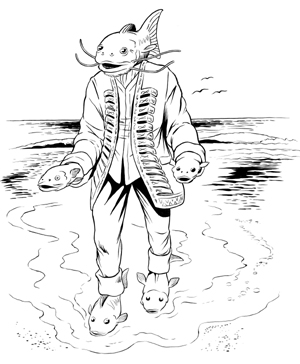
Once I got the notion of creating a fantasy-adventure series that was set in the New World instead of the Old World, I felt I had something I was excited about working with. And once I drew the first sketch of Adarro, the old man-of-fish, I knew this was it. I embraced the use of reference for the first time in my career, and set out to essentially learn to draw all over again, rather than keep repeating my old habits. For the story, I spent a good six months just daydreaming about it (instead of my typical meticulous note-taking). Characters began populating my head, the back story and logic of this world began to brew, and it became unstoppable. I think I had the first five issues written before the debut issue went to press. Unlike past series, where stories came during fits of insomnia or while dutifully sitting at a typewriter, the COLONIA stories have all come to me of their own will while I've been out hiking.
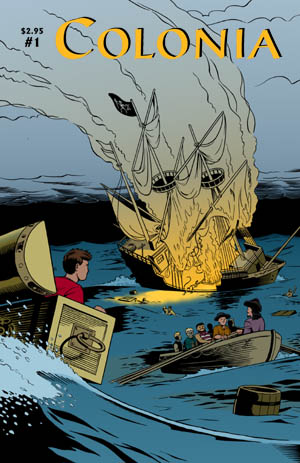
In the first issue of Colonia
Jack and his two uncles wash ashore of an unfamiliar
island, after escaping the hands of the pirate Cinnabar.
Still unsure of where, or when, his is, Jack encounters a
man made of fish and long lost Spanish Conquistadors. The
most rational being he meets is a talking duck named
Lucy, who is just as unfamiliar with the world Jack comes
from as he is of hers. As they consider joining forces,
they are shanghaied by yet another band of pirates. Click below for a tour of the first eight pages of Colonia #1.
A Colonia Preview

In the first five issue story arc of Colonia, Jack meets
a Norwegian colonist named Kelsey during his
adventure aboard the pirate ship of Anne Reed and Bonnie
O'Malley. Aside from the unpleasant prospect of
spending his summer in forced labor, there's also the
matter of arriving in the waters of the dreaded Fin-Men,
and keeping duck soup off the menu. While Cinnabar
catches up with Uncle Pete and Uncle Richard back on the
island, Jack experiences his first boarding party.
Also, Adarro, the old man-of-fish, arranges for Jack to
meet the eerie mermaid Teela, who answers the question of how our
trio from Massachusetts got to be in the world of Colonia. Jack is eventually reunited
with his uncles, only now they are all under the thumbs
of both Cinnabar and the pirate queen Anne Reed. A clever
plan must be hatched to regain their freedom, as they face a marooning
on the island of the Ghost Ship.
|
In 1999, while working on the first story arc, I did
an interview with a young Austin English, who came to my high rise day job office
one day and we did it by hanging out in an empty confernce room. In turned out to be one of my favorite
interviews because it was live (most interviews are actually via e-mail)
and we just had a really good chemistry. Unfortunately the interview
has long disappeared from the web, but I had a copy and Austin graciously
allowed me to post it here on my web site:
|
The Austin English Interview
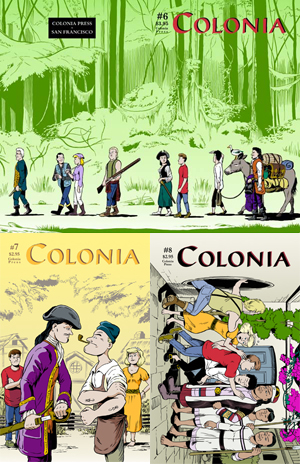
In the next story arc of Colonia, the ship
runs aground and the travellers turn from the sea to the interior.
Faced with seemingly endless miles of inhospitable Florida swampland, they are victims of a cruel irony. All of the water is tainted, perhaps by magic, and there is not a drop to drink. Their trek takes them to an old Spanish fort, which is populated, yet has no visible means of entry. The secret to the fort unlocks a secret to all of the New World Colonian Hemisphere.
Heading North in search of a civilized port town, Jack and company meet Sally, who hails from a nearby Pagan village. While these villagers live in harmony with the New World, they are feared by the superstitious pirates who hail from the Old World. Fears turn to reality when Sally’s ability to "way-hop" are given a sudden and dangerous boost by Jack, and they vanish into an alternate reality.
|
In 2004 I did another very enjoyable
interview with Alex Cahill of New Radio Comics. Alex caught some pretty candid stuff from
me that reflect the impending end of my attempt to make a living from comics.
This one has also disappeared from the web, but I had a copy and Alex graciously
allowed me to post it here on my web site:
|
The Alex Cahill Interview
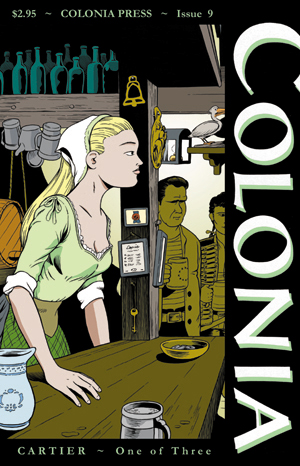

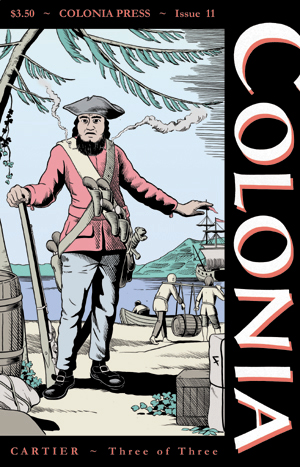
In the last story arc of Colonia, Jack and company finally arrive in the port town Cartier, where the barmaid at the Pelican Inn bears a striking resemblance to Teela the mermaid, Melmo the confounding beast has a conversation with Adarro down at the docks, and down-and-out pirates Stuart and Marco try and sell our heroes a ship.
Their plans are interrupted by rumors of an old man in the hills, who, like them, seems 300 years out of place. His name? What else... Rip Van Winkle. They take a detour to find him with hopes he has a clue to how they arrived in the world of Colonia in the first place. Perhaps the most surprising twist yet!
After finally negotiating their new ship, the entire town of Cartier is being held hostage by the notorious pirate Smokebeard, unless some brave individual will deliver him a chest of medicine. Cinnabar rises to the occasion, and Teela the mermaid has a run-in with Jack, setting up anticipation of further intrigue.
|
Ad used on the final Colonia Story Arc
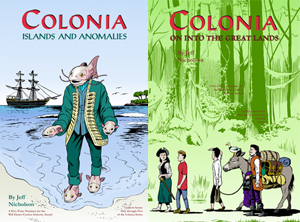
All eleven issues of Colonia are collected in two trade paperbacks, published by AiT/PlanetLAR. COLONIA: ISLANDS
& ANOMALIES and COLONIA: ON INTO THE GREAT LANDS. They both contain unpublished sketches and the best of the text back matter sections.
One of the books is missing a page, which can be found here: The Missing Page.
In 2005 I began work on the next collection COLONIA: THE WAY HOME. Unfortunately, I only created this cover, some fragmented scripts, and 17 pages of thumbnails
before making the decision to stop making comics.

In case the cover looks familiar, it's a tribute to Jack Kirby's Kamandi #11.
The Way Home thumbnails
FATHER AND SON TOONS: 2007-2013
I thought when I finished comics that I could just have a day job, hike my hikes, and enjoy life, but I don't seem to be able to do that.
I get kinda itchy and feel short circuited when not doing something creative that I think will reach people, so I needed a new outlet. I've always loved animation but historically it was too expensive and
time consuming. I got some software from ToonBoom Studios and after a learning curve started having fun with it.
It's still pretty time consuming so I was not animating so much as making audio comics. I still drew the backgrounds and most of the elements with traditional ink on bristol (because I'd rather be sitting at a drawing table than a computer if possible),
and then scan them in. I made five that way 2007-2009, and after a few years hiatus got a digital tablet for the sixth and last installment in 2013 which was all drawn directly in the software.
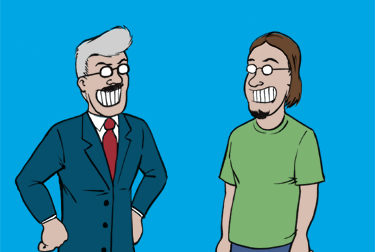
The nice thing about web animation is I no longer had to invest in printing and advertising, dealing with distributors and waiting on pins and needles for purchase orders, or filling my closets with overstock. When I finish one, I just slap it on the web. These days everybody is watching movies, tv shows, old music videos, and various forms of mindless entertainment on their PC.
It's a busy world competing for our attention out there, but at least there is a potential to grow an audience than to be guaranteed to lose it in the old print world.
|
All images ©2015 Jeff Nicholson, except
Spore photo by Becky Dunn ©1986 The Orion, Taboo #5 cover ©1991 SpiderBaby Grafix & Publications and ©1990,1991 Jeff Jones, The Dreaming #15 cover ©1997 DC Comics, LOST logo ©2004 ABC Studios.
Back
|
|
MUSIC: 1980-1992
Unlike cartooning, which goes back to my earliest memories, music started in the teen years. Also unlike comics,
which I later made a career of, playing and recording music always remained a hobby for me. Just for fun with no professional pretensions.

My brother Richard and I made mock albums under various pseudo names and with various friends, and in the latter years joined real bands that gigged and
recorded on more and more sophisticated equipment. To give you an idea of the depth of material, when I filter my iTunes for "home music," there are
18 bands representing 54 albums, and 591 songs.
Below are the liner notes and cover art of my burn-it-yourself CD era compilation, JEFFOLUTION, which touches on some of the recording projects and bands.
WHAT, WHY, IS JEFFOLUTION 1980-1988?
This is sort of a "best of" my solo junk
and the projects and bands I was
involved in, but also is an attempt
at a worts-and-all representation
of things put to tape from ages 17
to 25, including the spontaneous,
goofy, and intoxicated stuff.
DRUGS (2:47) excerpt from the "Concord Chronicles" April 1980.
My first time playing any stringed instrument, and first time memorizing a song, all caught on tape. Recorded live directly into a boom box condenser mike. Once I knew I could keep time and memorize notes, this whole guitar thing became appealing. However, nothing I recorded in the next two years that I wrote and played guitar on is very listenable.
LISTEN / CONVINCE ME (4:53) as "Low Fidelity" April 1982.
"Blue Oyster Cornwell," as a friend described it, since the influences were painfully lodged in Blue Oyster Cult and Hugh Cornwell (The Stranglers). Still, a bad-ass sound on guitar (naively run through a pawn shop country-western bass amp). And we are multi tracking thanks to a hot rodded 8 track cassette player. Nice lead chops by Rich. Now the official “Father & Son” toon theme song.
DRINK AND DANCE (3:46) as "Monocromagnon" February 1983.
Now multi tracking on standard cassette deck somehow (Rich had a knack for figuring out how to discriminately de-actitave the erase heads), since 8-tracks have no rewind which gets old. The first song utilizing "Drum Drops" (store bought drum tracks on both vinyl and cassette), which served us well until real bands and real drummers. My guitar solos start to come into their own here.
SLIM'S GENERAL STORE RAG (5:07) as "The Drunken Fools" May 1983.
All songs were actually recorded drunk with this bunch. Low tech, no practicing, and you probably had to be there kind of thing, but these beer sessions help keep the spontaneity up and taking ourselves seriously down. Back to the primitive boom box condenser mike live.
TEENAGE PASSION (3:00) as "The Frets" May 1983.
Now multi tracking properly on open reel, so the sound is getting clearer. A Buzzcocks wannabe song, if I ever wrote one. We blew up some tweeters trying to use home stereo speakers as monitors. If you listen closely you can hear the landlady’s dogs barking during the first bridge.
GOON OUTTA TUNE (2:15) as "Skizzy and the Screechers" September 1983.
Our own version of Spinal Tap. Skizzy is a luck-less, confused metal band with a complete history and three mock albums.
POT, POT, ALL FOR POT (5:44) as "The Totally Boatally Band" December 1983.
Although none as prolific as Skizzy, we had a lot of these mock "cartoon" bands. This one based on my pothead cousin. Obviously unrehearsed, recorded without overdubs, but it has some of my best spontaneous leads. Totally bad!
PAROLLED (5:58) as "Skizzy and the Screechers" February 1984.
More Skizzy. Our old progressive rock roots coming through on this one. Fun shit if not taken too seriously.
REASONS 2 (3:34) as "The Unrehearsables" April 1984.
The Unrehearsables were another side band like the DFs, except recording with a friend who didn't drink. An amazingly creative guy but he never committed any of his ideas to paper or memory. Just while the tape's rolling.
SHE'S KILLING ME (5:41) as "The Unrehearsables" April 1984.
There are six or seven albums worth of this Unrehearsables stuff. Here's one of the more raucous.
HARSH WINTER (1:51) as "Monocromagnon" May 1984.
Suddenly obsessed with LA hardcore like Black Flag and Circle Jerks, I made my own album of obnoxious 1 or 2 minute wonders. Here are two of 'em.
FUCK (:52) as "Monocromagnon" May 1984.
I think I am intentionally devolving musically here.
FRIGHTENED LOVERS (2:53) as "Monocromagnon" October 1984.
Jeff sings! College vocal and piano classes give confidence for 80's style ballad. Sharp contrast to the last track.
HELTER SKELTER (3:45) as "The Drunken Fools" December 1984.
The DFs also had six or seven albums worth of stuff, probably about half covers like this one.
I HATE THE MEDIA (3:22) as "Monocromagnon" June 1985.
Now multi tracking on 4-track cassette, buy the way. I was usually to lazy to take care with the recording process without Rich at hand, but took my time on this one solo.
PARANOID (1:25) as "The Drunken Fools" June 1985.
This new member of the DFs can hardly play guitar, but I still have fun with it.
WEIRD DASHBOARD (3:15) as "The Frets" November 1985.
Rich and I plunk out an ep of clean, drum-less goofs.
BEFORE I WAS ME (4:31) as "The Killjoys" November 1987.
My first band with a real drummer. These sessions are rough live ambient recordings in the practice shed.
GET OUTTA MY FACE (2:48) as "The Killjoys" January 1988.
Second round of sessions, this time live to the 4-track machine. The mix downs are crap. We only had one live gig (The Ice House, Chico) after this, then disbanded as a chickenshit way to get a different drummer.
JUST ONE PERSON (4:11) as "Mr Greenjeans" July 1988.
My only live show ever recorded (330 Wall Street, Chico). The sound is pretty weak, but I’m glad I caught at least one show before becoming a recording only guy. Listen, someone is actually clapping!
CAUGHT MYSELF THINKING (4:39) as "Mr Greenjeans" July 1988.
The drummer died of a drug overdose a few years later, which I guess makes me officially rock and roll.
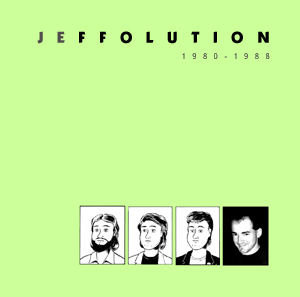
Before moving on to newer music, first a shout out to SPORE, one of my favorite local bands of all time, from my college days in Chico, CA.
In an alternate universe they would have been signed and had their day in the sun. My brother played with them for three years, and in 1988,
I was a member for one day as new bass player after the original left. But it was not to be and they never played again after that last rehearsal.

In late 1988 two things happened that led to a big rush of song writing in my life. I got a bass guitar, and I quit drawing comics for nearly a year. It was the first and only time the bass became the instrument I would primarily practice with and develop new songs from. The fact that it was a second-hand thrash bass left over from SPORE made it all the better.

With that rumbly old bass I came up with most everything on my final MONOCROMAGNON album, as well as the JEFF & PAUL album I co-authored with British bloke Paul Edwards, both of which were recorded over the course of 1989 to 1992.
|
|
|
|
|
|
|
|
|
|
|
|
|
|
|
|
|
|
|
|
|
|
|
|
|
|
|
|

|
|
|
|
|
|
|
|
|
|
|
|
|
|
|
|
|
|
|
|
|
|
|
|
|
|
|
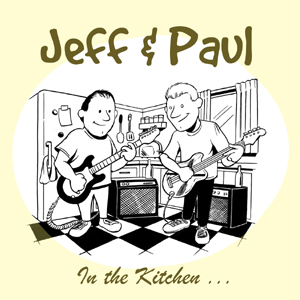
THE COLLECTED EDITIONS (TRADE PAPERBACKS): 1994-2003
My desire to get the entire Habitrails in print began a new phase in my career, the book editions that could be sold in bookstores as well as comic book specialty shops.
I thought I would turn a quick profit on these higher priced items but soon learned they are a long term investment. The first and second editions of Habitrails sold about
1,500 copies each, but over the course of about six years, that's a labor of love and not a livelihood. Still, they legitimized my past work, and unlike the comics issues,
are still readily available through Amazon.com and a host of other aftermarket web booksellers.
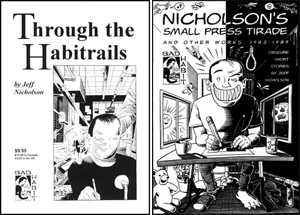
Above: The first out-of-print edition of Habitrails, which does not contain the new introduction or epilogue, and the Nicholson's Tirade trade paperback,
which contains all the early 80's small press work as well as the 1989 Tirade mini-comic

THROUGH THE HABITRAILS
$14.95
144 pages
Second edition. Introduction by Stephen R. Bissette.
ISBN 1-885047-03-7
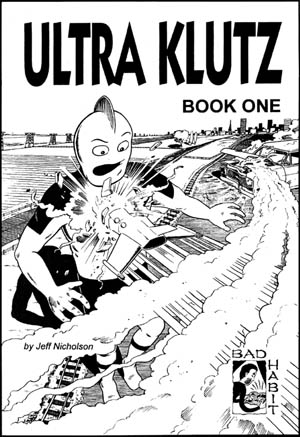
ULTRA KLUTZ BOOK ONE
$29.95
520 pages
Collects the first 23 issues plus unpublished material.
ISBN 1-885047-02-9
|
|
|
|
|
|
|
|
|
|
|
|
|
|
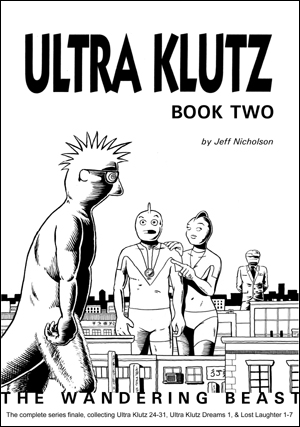
ULTRA KLUTZ BOOK TWO: THE WANDERING BEAST
$24.95
400 pages
Collects issues 24-31, Ultra Klutz
Dreams 1, and Lost Laughter 1-7, plus unpublished material.
ISBN 1-885047-04-5
|
|
|
|
|
|
|
|
|
|
|
|
|
|
|

FATHER & SON: EVERYBODY'S SELL-OUT
$9.95
120 pages
Collects the four Kitchen Sink issues plus one "lost episode"
and one unpublished page.
OUT OF PRINT
ULTRA KLUTZ TV PILOT STORYBOARDS: 2005
I briefly contemplated making a budget live action Ultra Klutz pilot called Ultra Sam. I don't know what I was smoking, but thought it would be fun to make an intentionally crude pastiche, making cheap models and sets in my apartment,
getting my girlfriend to sew costumes, and exploiting the patience of my friends to act the parts.
I didn't do any of that, but did get as far as writing and storyboarding a complete script. Imagine if you will,
that Ultra Sam is a guy in a rubber suit, with a hard shell mask (like on Ultraman), except whenever his mood changes, the hard mask is suddenly different. I still think that would look pretty funny.
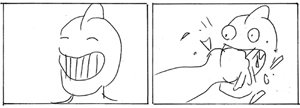
Here's the link to the complete script. Enjoy!
ULTRA SAM TV PILOT SCRIPT
iTunes LIBRARY: 2006-2007
I distracted myself during my withdrawl from creating comics by building my itunes library from all my CDs and 400 gigs of archived wave files. It took a year and a half to convert, tag, and assign album art for all of it!

LOST - Island Chronology: 2011
After learning to use software editing tools for my toons and old films and videos, I was bitten by the "fan edit" bug and created my own version of the television series LOST. I was so impressed with the
adherence to continuity on that show that I was inspired to make a re-edit to portray events taking place on the island in chronological order, from pre-history to the last days after Jacob.
Includes all flashbacks, time travel sequences, outtakes and webcasts, but no events off of the island, with the exception of the epilogue.
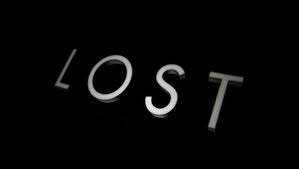
| | |

